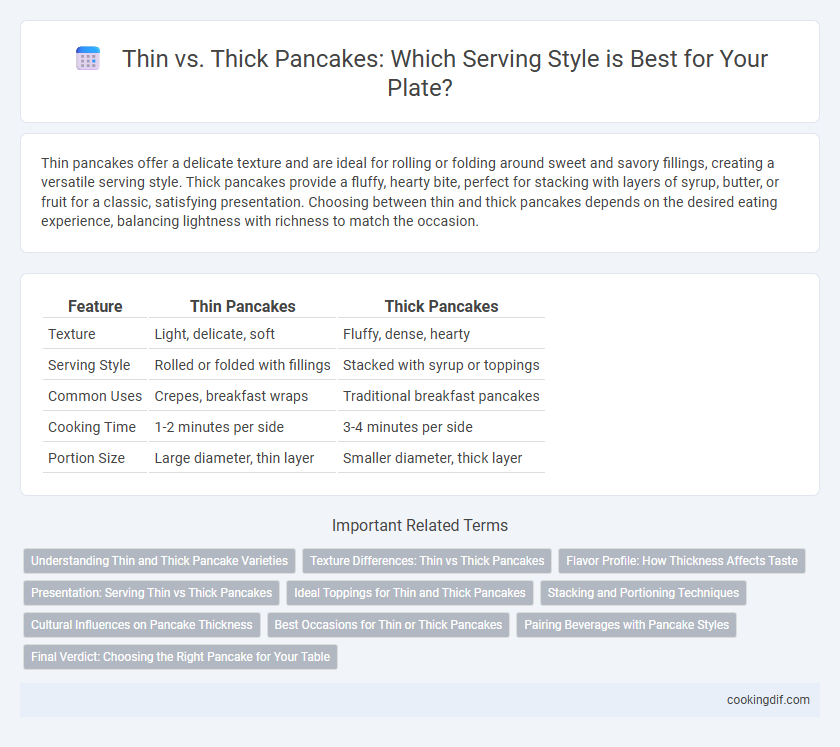Thin pancakes offer a delicate texture and are ideal for rolling or folding around sweet and savory fillings, creating a versatile serving style. Thick pancakes provide a fluffy, hearty bite, perfect for stacking with layers of syrup, butter, or fruit for a classic, satisfying presentation. Choosing between thin and thick pancakes depends on the desired eating experience, balancing lightness with richness to match the occasion.
Table of Comparison
| Feature | Thin Pancakes | Thick Pancakes |
|---|---|---|
| Texture | Light, delicate, soft | Fluffy, dense, hearty |
| Serving Style | Rolled or folded with fillings | Stacked with syrup or toppings |
| Common Uses | Crepes, breakfast wraps | Traditional breakfast pancakes |
| Cooking Time | 1-2 minutes per side | 3-4 minutes per side |
| Portion Size | Large diameter, thin layer | Smaller diameter, thick layer |
Understanding Thin and Thick Pancake Varieties
Thin pancakes, often called crepes, feature a delicate texture and are typically rolled or folded with sweet or savory fillings, making them ideal for elegant presentations and light servings. Thick pancakes, characterized by their fluffy and airy interior, are commonly stacked and served with syrup, butter, or fruit toppings, providing a hearty, comfort-food experience. Understanding these varieties helps tailor serving style to occasion, whether for a refined brunch or a casual family breakfast.
Texture Differences: Thin vs Thick Pancakes
Thin pancakes feature a delicate, tender texture with a slight crispness around the edges, making them ideal for folding or rolling with fillings. Thick pancakes offer a fluffy, airy interior and a soft crumb, providing a hearty bite that holds toppings like butter and syrup effectively. Texture differences significantly influence serving style, with thin pancakes suited for layered presentations and thick pancakes preferred for stacked servings.
Flavor Profile: How Thickness Affects Taste
Thin pancakes, often associated with crepes, have a delicate texture that allows subtle flavors like vanilla and citrus zest to shine through, enhancing the overall taste experience. Thick pancakes offer a hearty, fluffy bite that brings out rich, buttery notes and retains syrup and toppings longer, creating a more indulgent flavor profile. The thickness directly influences how ingredients meld, with thin pancakes providing a light, crisp base and thick pancakes delivering a moist, dense canvas for richer flavors.
Presentation: Serving Thin vs Thick Pancakes
Thin pancakes offer a delicate, almost crepe-like presentation that allows for elegant layering with fillings such as fresh fruit, whipped cream, or savory spreads. Thick pancakes create a visually substantial stack that emphasizes height and texture, often topped with butter and syrup for a rustic, hearty appeal. Choosing thin pancakes enhances refinement and intricate plating, whereas thick pancakes highlight comfort food aesthetics and robust serving portions.
Ideal Toppings for Thin and Thick Pancakes
Thin pancakes, often referred to as crepes, pair perfectly with light toppings such as fresh fruit, lemon juice, and powdered sugar, enhancing their delicate texture without overpowering it. Thick pancakes, on the other hand, are ideal for hearty toppings like maple syrup, butter, whipped cream, and bacon, providing a satisfying, indulgent breakfast experience. Choosing the right toppings ensures the perfect balance between pancake texture and flavor, catering to diverse serving styles.
Stacking and Portioning Techniques
Thin pancakes are ideal for elegant stacking as their lightweight layers create tall, delicate towers that highlight intricate presentation. Thick pancakes require careful portioning to ensure even cooking and prevent sogginess, making smaller stacks more practical for maintaining texture. Mastering the balance between thickness and portion size enhances serving style by optimizing both visual appeal and flavor absorption.
Cultural Influences on Pancake Thickness
Pancake thickness varies significantly across cultures, reflecting regional preferences and culinary traditions. French crepes are typically paper-thin and served rolled or folded with sweet or savory fillings, emphasizing delicate texture and presentation. In contrast, American pancakes are thicker and fluffier, often stacked and topped with syrup, butter, or fruit, showcasing a heartier, comfort-food style.
Best Occasions for Thin or Thick Pancakes
Thin pancakes, such as crepes, are ideal for elegant brunches or dessert presentations where delicate fillings like fruit, cream, or chocolate are showcased, offering a refined and light serving style. Thick pancakes, like traditional American flapjacks, suit hearty breakfasts or casual gatherings, providing a substantial base for toppings like syrup, butter, or bacon, perfect for fueling active mornings. Choosing thin or thick pancakes depends on the occasion's tone and desired presentation, balancing lightness with richness.
Pairing Beverages with Pancake Styles
Thin pancakes, such as crepes, pair exceptionally well with light and delicate beverages like herbal teas or sparkling white wines that complement their subtle flavor and delicate texture. Thick pancakes, often fluffy and dense, are best enjoyed with richer drinks like robust coffee or creamy hot chocolate, which balance their hearty consistency. Matching beverage choice enhances the overall dining experience by highlighting the unique characteristics of each pancake style.
Final Verdict: Choosing the Right Pancake for Your Table
Thin pancakes offer a delicate texture perfect for layering with fruits, syrups, or creams, ideal for elegant brunch spreads or dessert-style presentations. Thick pancakes provide a hearty, fluffy bite that satisfies as a standalone breakfast, pairing well with butter and maple syrup for a classic American meal. Selecting between thin and thick pancakes depends on whether the goal is a refined, versatile dish or a filling, comforting plate that anchors the table.
Thin vs thick pancakes for serving style Infographic

 cookingdif.com
cookingdif.com